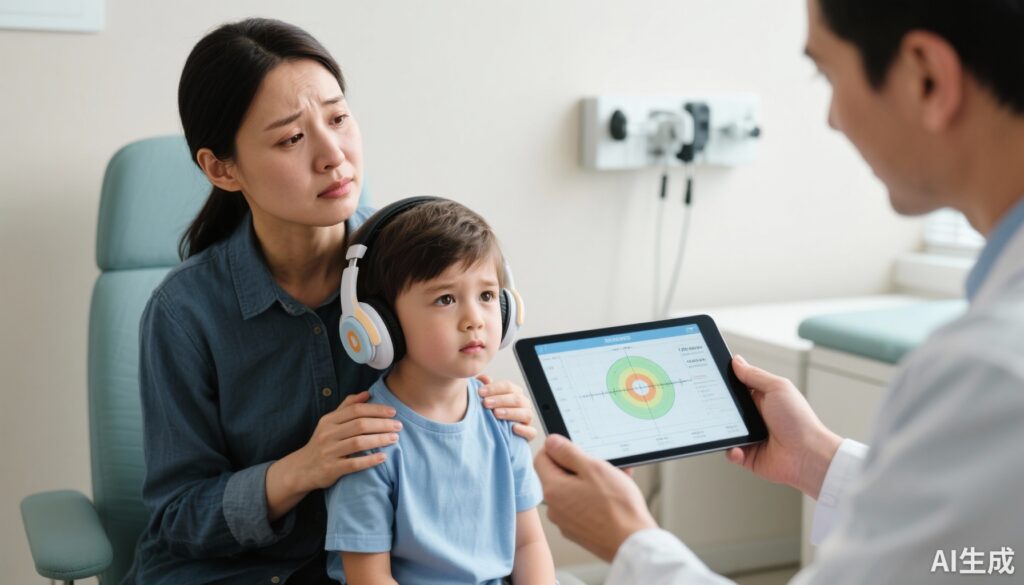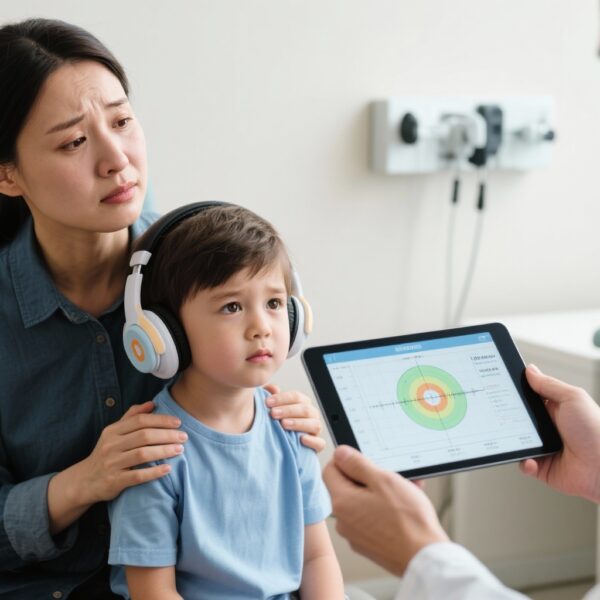Highlights
– New prospective cross-sectional data indicate unilateral pediatric COME is linked to reduced spatial release from masking (SRM) compared with controls and bilateral COME, despite similar average hearing thresholds in the poorer ear (~30 dB).
– Greater interaural threshold asymmetry predicts larger reductions in SRM benefit, independent of overall hearing loss or COME laterality.
– Tinnitus prevalence was high in both COME cohorts (71% unilateral, 55% bilateral) and tinnitus loudness correlated with mood symptoms and worse hearing-related quality of life.
– Findings raise concern that conservative management for unilateral COME (treatment only considered) could permit unrecognized central auditory and tinnitus sequelae; longitudinal intervention trials are needed before changing practice guidelines.
Background
Otitis media with effusion (OME), when persistent for 3 months or more, is commonly referred to as chronic otitis media with effusion (COME). COME is a leading cause of conductive mild-to-moderate hearing loss in childhood. The standard rationale for intervention—most commonly tympanostomy tube placement—is to restore conductive hearing and reduce the risk of speech, language, and educational sequelae. Current practice guidelines (which emphasize benefit for bilateral disease) generally recommend insertion of ventilation tubes for bilateral COME producing persistent hearing loss, while recommending only consideration of tube insertion for unilateral COME, reflecting a belief that unilateral conductive loss carries less functional risk and may resolve spontaneously (Rosenfeld et al., 2013).
Binaural hearing supports sound source segregation, spatial release from masking (SRM), sound localization, and selective attention in noisy, multi-talker environments—abilities crucial to classroom learning and social communication. Asymmetric hearing—differences in thresholds between ears—can degrade binaural processing even when the absolute degree of hearing loss is mild. Tinnitus in children, though under-recognized, can produce distress and negatively impact quality of life and mood. The recent study by Weinstein et al. (2025) investigates whether unilateral COME produces central auditory and tinnitus consequences that might be unrecognized if management is limited to “consideration” rather than active treatment.
Study design
Weinstein and colleagues conducted a prospective, cross-sectional study comparing three pediatric cohorts: (A) control children with normal hearing and no COME (N = 12), (B) bilateral COME (N = 11), and (C) unilateral COME (N = 7). Participants were aged 5.4–13.7 years (mean ≈ 9 years). Mean pure-tone thresholds in the poorer ear of the COME cohorts were approximately 30 dB—mild conductive loss and comparable between unilateral and bilateral groups.
Primary assessments included a portable spatial release from masking (SRM) test protocol to evaluate how well children used spatial cues to separate target speech from competing noise, and tinnitus loudness measurement using age-appropriate psychophysical or rating scales. The authors evaluated SRM performance across groups and examined relationships between interaural threshold asymmetry and SRM benefit. Tinnitus prevalence and relationships between tinnitus loudness, mood symptoms, and hearing-related quality of life were also analyzed.
Key findings
Spatial release from masking
The unilateral COME cohort demonstrated poorer SRM performance compared with controls and bilateral COME participants (p = 0.012). This indicates a reduced ability to gain benefit from spatial separation of target and masker sounds, a function that relies on intact binaural temporal and level cues. Importantly, the poorer SRM in the unilateral group occurred despite comparable mean hearing thresholds in the poorer ear across COME cohorts, emphasizing that interaural symmetry—in addition to absolute thresholds—matters for binaural processing.
Across the entire sample, greater interaural threshold asymmetry predicted a greater reduction in SRM benefit (F = 5.1, p = 0.033). The authors report that this relationship held regardless of whether participants had unilateral or bilateral COME and was independent of the absolute degree of hearing loss. In other words, asymmetry itself was a key driver of binaural-processing impairment.
Tinnitus prevalence and associations
Tinnitus was commonly reported: 71% of children with unilateral COME and 55% of those with bilateral COME experienced tinnitus. Tinnitus loudness correlated with measures of mood symptoms and with worse hearing-related quality of life. These findings suggest tinnitus in the setting of pediatric COME is not only frequent but also clinically meaningful, with potential psychosocial impact.
Effect sizes and clinical significance
The statistically significant SRM deficit in unilateral COME (p = 0.012) and the significant relationship between interaural asymmetry and SRM decrement (F = 5.1, p = 0.033) are notable given the small sample size. While precise effect sizes and confidence intervals are not fully expanded in the abstract, the results are hypothesis-generating and suggest clinically relevant decrements in functional hearing in noisy environments that are not captured by pure-tone thresholds alone.
Expert commentary and interpretation
This study highlights an important and underappreciated concept: mild, unilateral conductive deficits in children can translate into central auditory dysfunction. Spatial release from masking is a real-world proxy for classroom listening—reduced SRM likely translates to greater difficulty understanding speech in noisy settings, which can affect attention, learning, and social participation. The finding that interaural asymmetry predicts SRM loss aligns with basic auditory neuroscience: the binaural system depends on balanced inputs to encode interaural time and level differences.
Tinnitus prevalence in these cohorts—particularly the high rate in unilateral COME—reminds clinicians to actively screen children with middle ear disease for tinnitus and associated emotional distress. Pediatric tinnitus is often underreported or missed unless specifically asked.
However, several methodological caveats temper overinterpretation. The study is cross-sectional and relatively small, especially in the unilateral COME group (N = 7). Cross-sectional design precludes causal inference: it cannot definitively show that COME caused central auditory changes rather than that preexisting binaural vulnerabilities increased susceptibility to persistent effusion. Selection bias is possible if recruited children differ from those seen in routine practice. SRM testing using portable protocols is pragmatic and clinically relevant, but its psychometric properties in young children require continued validation across ages and hearing profiles. Tinnitus measurement in children relies on self-report and scaling, which can be challenging in younger ages and may introduce variability.
In the context of existing guideline recommendations (Rosenfeld et al., 2013), the study does not yet provide level 1 evidence to mandate a change in practice. Guidelines emphasize proof from randomized trials showing meaningful long-term gains. Nevertheless, this work identifies plausible, functionally important harms of untreated unilateral conductive asymmetry that are not measured by standard audiometry and suggests additional domains clinicians should assess when counseling families.
Clinical implications and pragmatic recommendations
Until longitudinal intervention trials are available, clinicians can incorporate several actionable steps informed by these findings:
- Systematically assess binaural function in children with COME, particularly unilateral disease—simple speech-in-noise or SRM-style screening can identify children with functional deficits.
- Screen explicitly for tinnitus and its psychosocial impact in children with COME; ask caregivers and children and use age-appropriate rating tools.
- Consider the degree of interaural asymmetry—not just absolute thresholds—when making individualized decisions about tympanostomy tube placement. Children with persistent asymmetry and functional hearing complaints in classrooms may be reasonable candidates for earlier intervention.
- Provide counseling to families about potential binaural and tinnitus consequences of persistent unilateral effusion, advising close monitoring and timely remedial action if functional problems arise.
Research gaps and priorities
Key research steps needed to translate these findings into evidence-based guideline changes include:
- Prospective longitudinal studies that follow children with unilateral and bilateral COME over time, tracking SRM, localization, speech-in-noise performance, tinnitus, language, and academic outcomes.
- Randomized controlled trials or comparative effectiveness designs with intervention arms (e.g., tympanostomy tube insertion vs watchful waiting) that include binaural functional endpoints (SRM, speech-in-noise tests) and patient-centered outcomes (quality of life, learning, tinnitus burden).
- Mechanistic studies using objective measures—auditory-evoked potentials, cortical imaging, and computational modeling—to characterize central auditory plasticity associated with asymmetric conductive loss and its reversibility after intervention.
- Validation and standardization of child-appropriate SRM and tinnitus assessment tools to enable multicenter trials and clinical screening.
Limitations of the study
Principal limitations include small sample size and cross-sectional design, which limits causal inference and generalizability. The unilateral cohort was particularly small (N = 7), raising risk for type I or II errors and limited ability to explore age or duration effects. The report does not provide full effect sizes or confidence intervals in the abstract summary, so exact magnitude and precision of observed differences are uncertain. Finally, the study population and recruitment methods may limit applicability to community settings.
Conclusion
Weinstein et al. provide early evidence that unilateral COME in children is associated with diminished spatial release from masking and a high prevalence of tinnitus—findings that point to potential central auditory and psychosocial consequences not captured by routine audiometry. The data raise a clinically important question: should unilateral COME be managed more proactively when it produces interaural asymmetry and functional hearing complaints? The study is hypothesis-generating and underscores the need for longitudinal, interventional research before guideline changes. Meanwhile, clinicians should consider routine assessment of binaural hearing and tinnitus in children with COME and adopt individualized decision-making that weighs asymmetry and functional impairments alongside conventional audiometric thresholds.
Funding and trial registration
Funding details and clinical trial registration were not reported in the abstract for Weinstein et al. (2025). Future trials should be prospectively registered and report funding sources transparently.
References
1. Weinstein JE, Sabes JH, Rose L, Cheung SW. Central auditory and tinnitus consequences of pediatric chronic otitis media with effusion. Hear Res. 2025 Oct;466:109404. doi: 10.1016/j.heares.2025.109404. Epub 2025 Aug 15. PMID: 40834816.
2. Rosenfeld RM, Shin JJ, Schwartz SR, et al. Clinical practice guideline: Tympanostomy tubes in children. Otolaryngol Head Neck Surg. 2013 Jan;149(1 Suppl):S1–S35. (American Academy of Otolaryngology—Head and Neck Surgery Foundation)
Note: Readers seeking to apply these findings should consult the full Weinstein et al. article for detailed methods, full statistical reporting, and authors’ discussion, and balance these data against established guideline recommendations while awaiting higher-level evidence.



